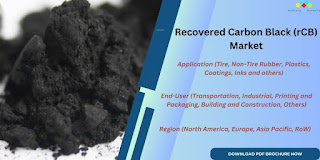Global rCB Market Trends: Size, Share, and Growth Analysis
Recovered Carbon Black (rCB) is a sustainable and environmentally friendly alternative to virgin carbon black, which is a critical component in the production of rubber and plastic products. Carbon black is a finely divided form of carbon used as a reinforcing filler in the rubber and tire industry, as well as in the manufacturing of various plastic products, inks, coatings, and more. The recovered carbon black market size is estimated at USD 55 million in 2018 and is projected to reach USD 491 million by 2023, at a CAGR of 55.0% between 2018 and 2023.
rCB is produced by recycling carbon black from end-of-life tires and other rubber products through a process known as pyrolysis. Pyrolysis involves heating the rubber or tires in the absence of oxygen, causing them to break down into their constituent components. During this process, carbon black is separated and recovered, hence the name "Recovered Carbon Black."
Download PDF Brochure: https://www.marketsandmarkets.com/pdfdownloadNew.asp?id=239229065
The advantages of using rCB include:
- Environmental Sustainability: Recycling carbon black reduces the need for extracting new carbon black from fossil fuels, which helps lower greenhouse gas emissions and conserves natural resources.
- Cost-Effective: rCB is often more cost-effective than virgin carbon black, making it an attractive option for manufacturers looking to reduce production costs.
- Performance: rCB can offer similar performance characteristics to virgin carbon black, making it a suitable replacement in many applications.
- Reduced Waste: The recycling of carbon black from end-of-life tires and rubber products helps reduce waste and promotes a circular economy.
- Regulatory Compliance: Using rCB can align with environmental regulations and sustainability goals, as it reduces the environmental impact of manufacturing processes.
- The market for Recovered Carbon Black (rCB) has a range of applications across various industries. Here are some of the key application areas for rCB:
- Tire Manufacturing: One of the primary applications of rCB is in tire manufacturing. It can replace a portion of the virgin carbon black typically used as a reinforcing filler in tire compounds. Using rCB in tire production can reduce costs and environmental impact.
- Non-Tire Rubber Products: rCB is also used in the production of non-tire rubber products, such as conveyor belts, hoses, seals, gaskets, and rubber sheets. These applications benefit from the cost savings and sustainability advantages of using rCB.
- Plastics: rCB can be incorporated into various plastic products, including automotive parts, pipes, cables, and consumer goods. It can enhance the mechanical properties of plastics and reduce the carbon footprint of plastic manufacturing.
- Coatings: In the coatings industry, rCB is used as a pigment and reinforcing agent in paints, coatings, and inks. It provides coloration, UV protection, and improved durability to coatings while reducing costs.
- Inks: rCB is used as a black pigment in printing inks for applications in packaging, publishing, and various printing processes. It helps achieve consistent coloration and print quality.
- Construction Materials: Some construction materials, such as rubberized asphalt and sealants, may incorporate rCB to improve their performance and sustainability.
- Automotive Components: rCB can be used in automotive components such as automotive belts, hoses, and rubber gaskets, contributing to weight reduction and improved fuel efficiency in vehicles.
- Footwear: The footwear industry may use rCB in the production of shoe soles and other rubber components.
- Other Industrial Applications: rCB finds applications in various other industrial products where carbon black is traditionally used, including electrical cables, adhesives, and industrial rubber products. Inquire Before Buying:
Inquire Before Buying: https://www.marketsandmarkets.com/Enquiry_Before_BuyingNew.asp?id=239229065
APAC is estimated to be the fastest-growing market for recovered carbon black, in terms of value.
The Asia-Pacific (APAC) region is projected to be the fastest-growing market for recovered carbon black (rCB) during the forecast period. This growth is attributed to factors such as increasing industrialization, rising environmental awareness, government regulations promoting sustainability, cost benefits, and ongoing market development in the region. rCB is gaining traction as a sustainable alternative to virgin carbon black, particularly in industries like rubber and tires.
Recovered Carbon Black (rCB) Market Key Players
The leading players in the recovered carbon black market are Pyrotek (Germany), Delta Energy Group (US), Black Bear Carbon(Netherlands), Scandinavian Enviro Systems AB (publ) (Sweden), Klean Industries (Canada), Radhe Group of Energy (India), Alpha Carbone (France), Bolder Industries (US), Dron Indústria De Equipamentos Elétricos (Slovakia), DVA Renewable Energy (Vietnam), Enrestec (Taiwan), Integrated Resource Recovery (US), and SR2O Holdings (US), Eneform (New Zealand), Doublestar Group (China), Carbon Recovery GmBh (Austria) and others.



.png)
Comments
Post a Comment